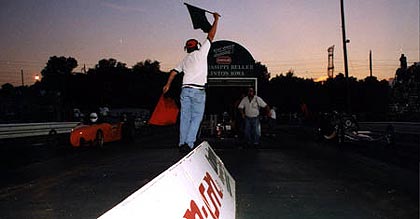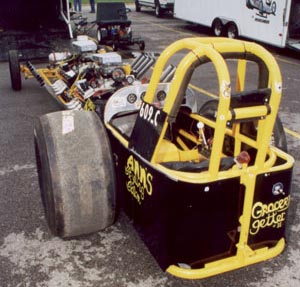|

The atmosphere extended beyond iron. The 10,000 fans filled the dragstrip
to overflow, and a dreamlike bunch they were. At Cordova, you can buy
a 12-oz. can of beer for a buck, a six-pack for $5, and 16-oz. margaritas.
I swear up and down I did not see one untoward incident during the event.
No cherry-tops racing to break-up a pair of tanked-up, tank-topped rednecks.
No relief in the bushes.
No pit-parking pile-ups. Nothing like that all.
The scene at Cordova; twilight in the countryside by the Mississippi
River, the two-story tower like a beacon fronting two quarter-mile multi-colored
stretches of bleachers surrounded by lawn and stands of trees, two wingspans
of fire scorching the center of the picture.
This for me was the kind of drag racing that hooked me on a sport that
an act-up, bookish left-wing, atheistic nut had no business liking.
The great show, the crowds, the atmosphere. Today drag racing tends
to lean toward the NHRA CEO Nationals or the IHRA Security Guard Non-Publicized
Championships. They're fun in their own and limited way, but have all
the heart of an Enron stock option.
Following are just a few of the highlights of the Burkster, Chrissie,
and Lennie's annual vacation.
BOB WITZEL'S TWIN CADILLAC SMOKER

The Stanton, Michigan performer's twin, in-line Cadillac dragster was
the first car we saw that caught our eye in the Cordova pits. The thing
is frightening at first glance. One-and-half-inch steel tubing stretches
about 210 inches long when pulled from a roughed up old school bus reconstructed
into an Iron Age race car trailer. The Cadillacs are 640 cubic inches
apiece with the whole package tipping in at 2,600 pounds. The garish
and large yellow roll cage (Witzel used to weigh 300 pounds) and a black-backgrounded
paint job complete with flames seals the deal.
|